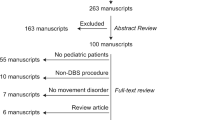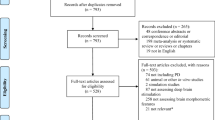Abstract
Introduction
DBS is initially used for treatment of essential tremor and Parkinson’s disease in adults. In 1996, a child with severe life-threatening dystonia was offered DBS to the internal globus pallidus (GPi) with lasting efficacy at 20 years. Since that time, increasing number of children benefited from DBS.
Patients and methods
We retrospectively evaluated our database of patients who underwent DBS from 2011 to 2017. All patients ≤ 17 years of age at the time of implantation of DBS were included in this series. Subjective Benefit Rating Scale (SBRS), Hoehn Yahr Scale (HYS), Fahn Marsden Rating Scale (FMRS), Clinical Global Impressions Scales (CGI), and Yale Global Tic Severity Scale (YGT) were used to evaluate clinical outcome.
Results
Between May 2014 and October 2017, 11 children underwent DBS procedure in our institution. Six of them were female and five of them were male. Mean age at surgery was 11.8 ± 4.06 years (range 5–17 years). In our series, four patients had primary dystonia (PDY) (36.3%), three patients had secondary dystonia (SDY) (27.2%), two patients had JP (18.1%), and two patients had Tourette Syndrome (TS) (18.1%). Two JP patients underwent bilateral STN DBS while the other nine patients underwent bilateral GPi DBS. SBRS scores were 1.75 ± 0.5 for patients with PDY, 3 ± 0 for patients with JP, 2.5 ± 0.7 for patients with TS, and 2 ± 1 for patients with SDY. Mean FMRS reduction rate was 40.5 for patients with dystonia. Significant improvement was also defined in patients with TS and JP after DBS. None of the patients experienced any intracerebral hemorrhage or other serious adverse neurological effect related to the DBS. Wound complications occurred in two patients.
Conclusion
There are many literatures that support DBS as a treatment option for pediatric patients with medically refractory neurological disorders. DBS has replaced ablative procedures as a treatment of choice not only for adult patients, but also for pediatric patients. Wound-related complications still remain the most common problem in pediatric patients. Development of smaller and more flexible hardware will improve quality of children’s life and minimize wound-related complications in the future.
Similar content being viewed by others
Abbreviations
- AC:
-
anterior commissure
- ADHD:
-
attention-deficit hyperactivity disorder
- CGI:
-
Clinical Global Impressions Scales
- Cm–PoF:
-
centromedian–parafascicular nuclear complex of the thalamus
- CP:
-
cerebral palsy
- CT:
-
computerized tomography
- DBS:
-
deep brain stimulation
- FMRS:
-
Fahn Marsden Rating Scale
- GPi:
-
internal globus pallidus
- HYS:
-
Hoehn Yahr Scale
- ICU:
-
intensive care unit
- JP:
-
juvenile parkinsonism
- MER:
-
microelectrode recording;
- MPAN:
-
mitochondrial membrane protein-associated neurodegeneration
- MRI:
-
magnetic resonance imaging
- NAc:
-
nucleus accumbens
- NBIA:
-
neurodegeneration with brain iron accumulation
- OCD:
-
obsessive compulsive disorder
- PC:
-
posterior commissure
- PD:
-
Parkinson’s disease
- PDY:
-
primary dystonia
- PGD:
-
primary generalized dystonia
- PINK1:
-
PTEN-induced putative kinase 1
- PKAN:
-
pantothenate-kinase-associated neurodegeneration
- SBRS:
-
Subjective Benefit Rating Scale
- SDY:
-
secondary dystonia
- STN:
-
subthalamic nucleus
- TS:
-
Tourette syndrome
- YGT:
-
Yale Global Tic Severity Scale
References
Lipsman N, Ellis M, Lozano AM (2010) Current and future indications for deep brain stimulation in pediatric populations. Neurosurg Focus 29(2):E2. https://doi.org/10.3171/2010.5.FOCUS1095
Cif L, Coubes P (2017) Historical developments in children’s deep brain stimulation. European journal of paediatric neurology : EJPN : official journal of the European Paediatric Neurology Society 21(1):109–117. https://doi.org/10.1016/j.ejpn.2016.08.010
Olaya JE, Christian E, Ferman D, Luc Q, Krieger MD, Sanger TD, Liker MA (2013) Deep brain stimulation in children and young adults with secondary dystonia: the Children’s Hospital Los Angeles experience. Neurosurg Focus 35(5):E7. https://doi.org/10.3171/2013.8.FOCUS13300
Comella CL, Leurgans S, Wuu J, Stebbins GT, Chmura T, Dystonia Study G (2003) Rating scales for dystonia: a multicenter assessment. Movement disorders : official journal of the Movement Disorder Society 18(3):303–312. https://doi.org/10.1002/mds.10377
Busner J, Targum SD (2007) The clinical global impressions scale: applying a research tool in clinical practice. Psychiatry 4(7):28–37
Leckman JF, Riddle MA, Hardin MT, Ort SI, Swartz KL, Stevenson J, Cohen DJ (1989) The Yale Global Tic Severity Scale: initial testing of a clinician-rated scale of tic severity. J Am Acad Child Adolesc Psychiatry 28(4):566–573. https://doi.org/10.1097/00004583-198907000-00015
DiFrancesco MF, Halpern CH, Hurtig HH, Baltuch GH, Heuer GG (2012) Pediatric indications for deep brain stimulation. Child’s nervous system : ChNS : official journal of the International Society for Pediatric Neurosurgery 28(10):1701–1714. https://doi.org/10.1007/s00381-012-1861-2
Fahn S (2011) Classification of movement disorders. Movement disorders : official journal of the Movement Disorder Society 26(6):947–957. https://doi.org/10.1002/mds.23759
Bhidayasiri R (2006) Dystonia: genetics and treatment update. Neurologist 12(2):74–85. https://doi.org/10.1097/01.nrl.0000195831.46000.2d
Kupsch A, Benecke R, Muller J, Trottenberg T, Schneider GH, Poewe W, Eisner W, Wolters A, Muller JU, Deuschl G, Pinsker MO, Skogseid IM, Roeste GK, Vollmer-Haase J, Brentrup A, Krause M, Tronnier V, Schnitzler A, Voges J, Nikkhah G, Vesper J, Naumann M, Volkmann J, Deep-Brain Stimulation for Dystonia Study G (2006) Pallidal deep-brain stimulation in primary generalized or segmental dystonia. N Engl J Med 355(19):1978–1990. https://doi.org/10.1056/NEJMoa063618
Marks WA, Honeycutt J, Acosta F, Jr., Reed M, Bailey L, Pomykal A, Mercer M (2011) Dystonia due to cerebral palsy responds to deep brain stimulation of the globus pallidus internus. Movement disorders : official journal of the Movement Disorder Society 26 (9):1748–1751. doi:https://doi.org/10.1002/mds.23723
Keen JR, Przekop A, Olaya JE, Zouros A, Hsu FP (2014) Deep brain stimulation for the treatment of childhood dystonic cerebral palsy. J Neurosurg Pediatr 14(6):585–593. https://doi.org/10.3171/2014.8.PEDS141
Lobel U, Schweser F, Nickel M, Deistung A, Grosse R, Hagel C, Fiehler J, Schulz A, Hartig M, Reichenbach JR, Kohlschutter A, Sedlacik J (2014) Brain iron quantification by MRI in mitochondrial membrane protein-associated neurodegeneration under iron-chelating therapy. Annals of clinical and translational neurology 1(12):1041–1046. https://doi.org/10.1002/acn3.116
Yilmaz S, Gokben S, Ceylaner S (2015) Mitochondrial membrane protein-associated neurodegeneration. Pediatr Neurol 53(4):373–374. https://doi.org/10.1016/j.pediatrneurol.2015.06.012
Schneider SA, Dusek P, Hardy J, Westenberger A, Jankovic J, Bhatia KP (2013) Genetics and pathophysiology of neurodegeneration with brain iron accumulation (NBIA). Curr Neuropharmacol 11(1):59–79. https://doi.org/10.2174/157015913804999469
Mahoney R, Selway R, Lin JP (2011) Cognitive functioning in children with pantothenate-kinase-associated neurodegeneration undergoing deep brain stimulation. Dev Med Child Neurol 53(3):275–279. https://doi.org/10.1111/j.1469-8749.2010.03815.x
Aydin S, Abuzayed B, Uysal S, Unver O, Uzan M, Mengi M, Kizilkilic O, Hanci M (2013) Pallidal deep brain stimulation in a 5-year-old child with dystonic storm: case report. Turkish neurosurgery 23(1):125–128. https://doi.org/10.5137/1019-5149.JTN.4579-11.0
Schrock LE, Mink JW, Woods DW, Porta M, Servello D, Visser-Vandewalle V, Silburn PA, Foltynie T, Walker HC, Shahed-Jimenez J, Savica R, Klassen BT, Machado AG, Foote KD, Zhang JG, Hu W, Ackermans L, Temel Y, Mari Z, Changizi BK, Lozano A, Auyeung M, Kaido T, Agid Y, Welter ML, Khandhar SM, Mogilner AY, Pourfar MH, Walter BL, Juncos JL, Gross RE, Kuhn J, Leckman JF, Neimat JA, Okun MS, Tourette Syndrome Association International Deep Brain Stimulation D, Registry Study G (2015) Tourette syndrome deep brain stimulation: a review and updated recommendations. Movement disorders : official journal of the Movement Disorder Society 30(4):448–471. https://doi.org/10.1002/mds.26094
Thomsen TR, Rodnitzky RL (2010) Juvenile parkinsonism: epidemiology, diagnosis and treatment. CNS drugs 24(6):467–477. https://doi.org/10.2165/11533130-000000000-00000
Genc G, Apaydin H, Gunduz A, Poyraz C, Oguz S, Yagci S, Canaz H, Aydin S, Gundogdu-Eken A, Basak AN, Ertan S (2016) Successful treatment of juvenile parkinsonism with bilateral subthalamic deep brain stimulation in a 14-year-old patient with parkin gene mutation. Parkinsonism Relat Disord 24:137–138. https://doi.org/10.1016/j.parkreldis.2016.01.018
Courchesne E, Chisum HJ, Townsend J, Cowles A, Covington J, Egaas B, Harwood M, Hinds S, Press GA (2000) Normal brain development and aging: quantitative analysis at in vivo MR imaging in healthy volunteers. Radiology 216(3):672–682. https://doi.org/10.1148/radiology.216.3.r00au37672
Author information
Authors and Affiliations
Corresponding author
Ethics declarations
This study was approved by the institutional review board of Istanbul Bilim University, Istanbul, Turkey.
Conflict of interest
There are no conflicts of interest.
Rights and permissions
About this article
Cite this article
Canaz, H., Karalok, I., Topcular, B. et al. DBS in pediatric patients: institutional experience. Childs Nerv Syst 34, 1771–1776 (2018). https://doi.org/10.1007/s00381-018-3839-1
Received:
Accepted:
Published:
Issue Date:
DOI: https://doi.org/10.1007/s00381-018-3839-1




